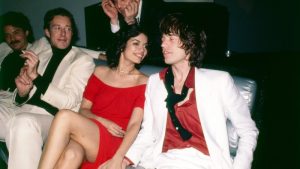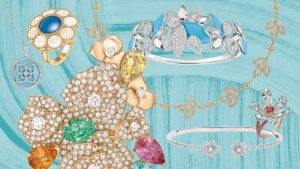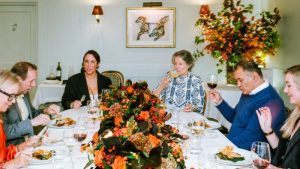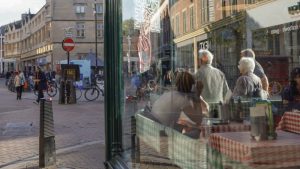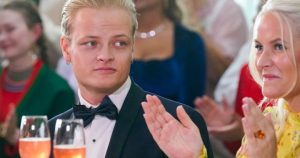John and Bob Crowley, brothers in arts
“For the first 10 or 11 years of my life, Bob was of no consequence to me. He was, at best, a distraction,” confesses the Irish film and theatre director John Crowley of his older brother Bob, 17 years his senior. Bob left home in Cork when John was still a child, and his brother little realised that he would one day follow the same path into the theatre – directing an award-winning production of The Pillowman, by Martin McDonagh and Stephen Sondheim’s Into the Woods – and later films, such as Boy A and Brooklyn.
John, 55, is visiting Bob while promoting his new film, We Live in Time. A heart-tugging story about family, love and loss, it stars Florence Pugh and Andrew Garfield and is scheduled for a UK release on 1 January. Today, he looks adoringly at his older brother, a multi-award-winning scenic and costume designer. Now 72, Bob has enjoyed a long and prestigious career working in opera, ballet and theatre. He set the visual language for works such as Peter Morgan’s The Audience, the Tony-award-winning The Inheritance, The History Boys and some of the West End’s most successful musicals as well. September saw the return of The Royal Ballet’s Alice’s Adventures in Wonderland and La Traviata at Covent Garden, as well as Giant at the Royal Court, a play by Mark Rosenblatt starring John Lithgow as the writer Roald Dahl. It is directed by his long-time friend and collaborator Sir Nicholas Hytner. He will soon start work on a season of three plays starring Ralph Fiennes in Bath.


The brothers are seated in the light-flooded sitting room of Bob’s Georgian house in Bloomsbury. The space is full of warmth and colour. Family photos are scattered around; there’s a huge Terence Donovan photograph of Bob’s hero Jimi Hendrix above a Georgian writing desk, and a large painting of a palm tree by Howard Hodgkin is flanked by a pair of Gaudi armchairs designed by Vico Magistretti.
The pair are very close, sharing the same soft southern Irish lilt and lively talent for storytelling. “Bob was gone for most of my early childhood,” says John, who was only five when Bob joined the Bristol Old Vic theatre school. “I was born in 1969 and he in 1952. It was like we came from different eras. When he did come home to Cork it was with what I used to describe as his ‘hippie friends’. People who would sit on the floor with strange-smelling cigarettes – and the big offence to me was that they would command the flipping record player!”
As children, the brothers – along with their two sisters Marie and Deidre – grew up in a home that was creative, but not one in which an artistic path was considered viable. “Our father was a fireman by day,” says Bob, “but whenever he had downtime, it was always spent making things: restoring furniture and buying antiques and French-polishing things. He even made the bed I slept in. I still have a lot of the pieces in this house.”



Bob decided early on a career in the arts. “I developed my love of theatre from when I was a small child,” he remembers. “I was the first child, totally spoilt by my parents, my aunts and my grandparents who all adored taking me to see lots of shows, especially musicals.” The path was set when, as a teenager, he saw Oliver! (designed by a fellow Irishman, Sean Kenny) and felt inspired. “He’d taken all the scenery away and revealed the walls of the theatre and the lighting rig. I remember thinking, ‘What is that? I want to know more about that.’ That was the spark.”
Bob’s move to London was typical of many young Irish professionals of the time. He describes emigrating as “the Brooklyn experience”. That novel, by Colm Tóibín, follows a young Irish woman to New York as she searches for work in the ’50s, and was remade as a film by John in 2015 starring Saoirse Ronan. The film speaks to many of the heartaches of leaving loved ones behind to build a better future. “That was me!” says Bob. “I vividly remember that there was a strong element that you had to leave in order to better yourself.”
John recalls his parents’ anxiety about their firstborn. “If Bob came back for Christmas, our mum used to whisper to me to ask him when he was coming back for good. There was a nervousness about actually following a creative path that perhaps suggested to her that penury was around the corner. By the time I left, years later, there was much less stigma around it, and I came and went all the time. I was part of the Ryanair generation and emigrating wasn’t as binary. It wasn’t until 1997 that I settled in England to direct at the National Theatre.”
John’s creative flame was lit while watching his older brother. “I would visit him in London and sit in the back of the stalls wearing my Walkman, and just watch. Those visits just seeped into me. So much of what I still know instinctively when I’m working stems from those days. It was like osmosis. Bob was like a doorway into another world and those visits were so rich and interesting.”



Bob provided John with an artistic education that touched every creative genre. “He would play me records, Tom Petty, The Police, The Beat and Bill Withers, and he would take me to see films like Blade Runner and Brazil. They were a revelation. It led me to get into acting at Cork University… It turned out I was no good at that, but it was while staying with Bob and watching the technical rehearsals of Les Liaisons Dangereuses at the Barbican, directed by Howard Davies in 1986, that I realised directing was what I wanted to do for the rest of my life.”
The brothers have only worked together once, in 1998, on a production of Sondheim’s Into the Woods at the Donmar Warehouse. “It was very hard!” remembers John. “Bob is my hero and that complicated things. I was very self-conscious when we worked together, and I also didn’t really feel ready to be working with someone as esteemed as Stephen Sondheim who was so excited about working with Bob… I knew I needed to go out and find my own voice.”
Simultaneously, John was also “falling in love with film”. Initially, the idea of breaking into movies “felt exotic, it was like wanting to join NASA”. But he realised there was a generation of theatre directors around him “like Stephen Daldry, Sam Mendes, Nicholas Hytner and Roger Michell – and they were making interesting films. I realised that although I knew nothing about it, I could give it a shot.” In 2000, he filmed an adaptation of Samuel Beckett’s Come and Go and so began his film career.
Bob insists that he has no interest in film. “I tried it a couple of times but I don’t love it.” (He did, however, create the set and costumes for the seminal Duran Duran video The Wild Boys.) “I just didn’t find the process particularly nurturing,” he shrugs.
“I think you need to try and make a film with me,” says John. “I think we could have a lot of fun!”
“Maybe,” laughs Bob. “Maybe that’s the answer!”


These days, Bob and John try to get together every few weeks, mostly for family Sunday lunches: John and his wife Fiona now have a home in west London. But there’s also Ireland: Bob has a cottage he’s restored in West Cork and there is a barn he’s converted for John and his family to come to stay in. The brothers love it there and go as often as possible. “We all went there as children,” says John. “I remember Bob coming to stay from London. It was the famous hot summer of 1976 and he brought a vinyl album of Kiki Dee and Elton John singing ‘Don’t Go Breaking My Heart’.”
“Don’t knock it!” laughs Bob, “It was a great song!”
And now, all these years later, when the family all come together, is it film and theatre that represents the map of their lives? “No!” say the Crowley brothers in unison. “We talk about records!”
#John #Bob #Crowley #brothers #arts

